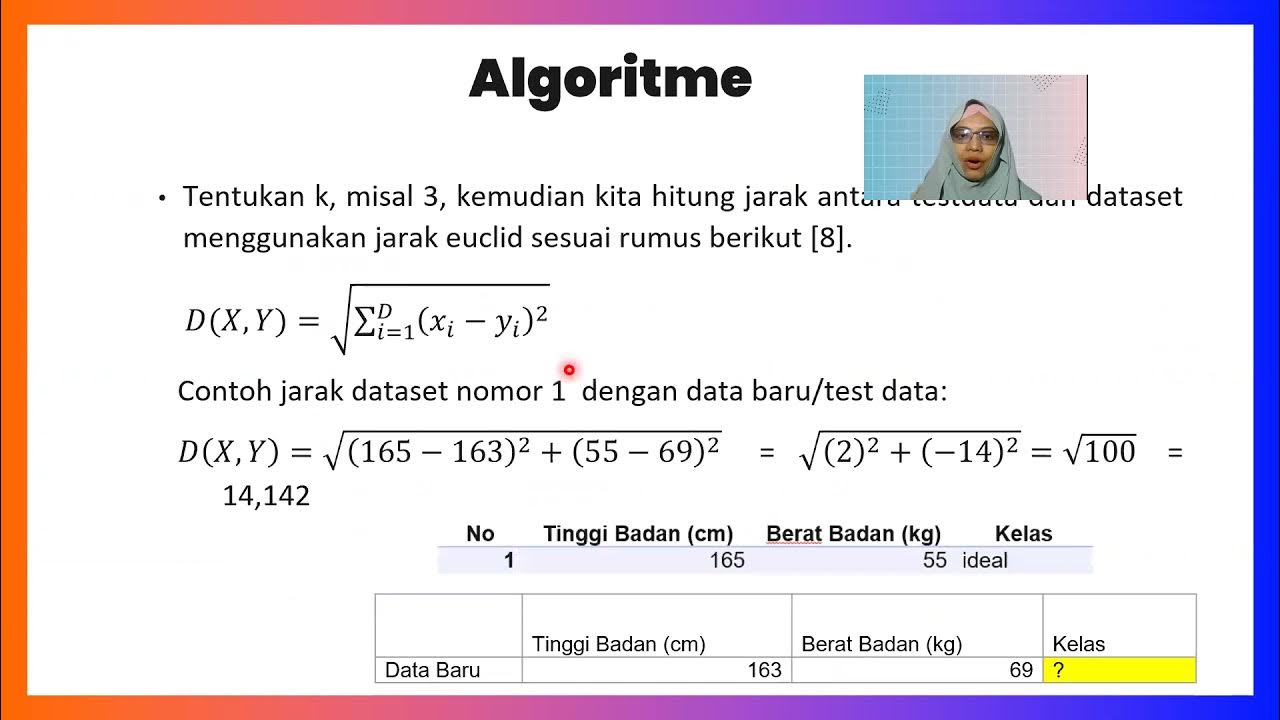K Nearest Neighbors | Intuitive explained | Machine Learning Basics
Summary
TLDRThe K-Nearest Neighbors (KNN) algorithm is a simple supervised learning method used for both classification and regression problems. It classifies points based on their proximity to other points, using a distance function like Euclidean distance. The classification is determined by a majority vote of the k nearest neighbors, and for regression, it's the average of the neighbors' labels. The optimal value of k balances overfitting and underfitting, which can be fine-tuned through cross-validation. The video also includes a code example with the Iris dataset, demonstrating the effect of different k values on classification decision boundaries.
Takeaways
- 😀 K-Nearest Neighbor (KNN) is a simple supervised machine learning algorithm used for both classification and regression tasks.
- 😀 To classify a point, the KNN algorithm calculates the distance between the given point and other data points, often using Euclidean distance.
- 😀 The nearest neighbors are sorted by distance, and for classification, the point is assigned to the class that is most common among its k nearest neighbors.
- 😀 The 'k' value in KNN controls the balance between overfitting and underfitting. A small 'k' leads to low bias but high variance, while a large 'k' leads to high bias but low variance.
- 😀 The optimal 'k' value can be found through cross-validation and analyzing learning curves.
- 😀 For regression problems, KNN predicts the value by taking the average of the k nearest neighbors' values.
- 😀 The script uses the Iris dataset, specifically the first two features, to demonstrate the KNN algorithm.
- 😀 Scikit-learn’s KNN implementation is simple and self-explanatory, making it easy for users to experiment with different parameters.
- 😀 Two plots visualize the decision boundary for classification with different 'k' values: the left one with k=15 and the right one with k=3.
- 😀 The video encourages viewers to experiment with KNN by adjusting parameters to understand how they impact the model’s performance.
- 😀 The video is part of the 'Bitesize ML Concept' series, and viewers are encouraged to engage by commenting, liking, and subscribing for more content.
Q & A
What is the K nearest neighbor (KNN) algorithm used for?
-The K nearest neighbor (KNN) algorithm is a simple supervised machine learning algorithm used for both classification and regression problems.
How does the KNN algorithm classify a point?
-In classification, the KNN algorithm classifies a point by taking a vote from its k nearest neighbors. The point is assigned to the class most common among its neighbors.
What is the purpose of calculating distances in KNN?
-The distances are calculated between the given point and other points in order to determine the k nearest neighbors. This is done to classify or predict the value of the given point based on the neighbors.
What is the most commonly used distance function in KNN?
-The most commonly used distance function in KNN is the Euclidean distance.
What role does the 'k' value play in the KNN algorithm?
-The 'k' value controls the balance between overfitting and underfitting. A small 'k' value can lead to low bias but high variance, while a large 'k' value can result in high bias but low variance.
How is the optimal 'k' value determined?
-The optimal 'k' value is typically determined using cross-validation and learning curves, where different 'k' values are tested to find the best one.
What happens when the KNN algorithm is used for regression?
-In regression, the KNN algorithm predicts the value of a point by taking the average of the values of its k nearest neighbors.
What dataset was used in the script to demonstrate the KNN algorithm?
-The script uses the famous Iris dataset, taking only the first two features for demonstration purposes.
What is shown in the plots presented in the script?
-The plots show the classification decision boundaries for different values of 'k'. The left plot has k = 15, and the right plot has k = 3.
What effect does the value of 'k' have on the classification decision boundary?
-A smaller 'k' value (like k = 3) tends to create a more complex decision boundary with higher variance, while a larger 'k' value (like k = 15) smooths the decision boundary and reduces variance, potentially increasing bias.
Outlines

Dieser Bereich ist nur für Premium-Benutzer verfügbar. Bitte führen Sie ein Upgrade durch, um auf diesen Abschnitt zuzugreifen.
Upgrade durchführenMindmap

Dieser Bereich ist nur für Premium-Benutzer verfügbar. Bitte führen Sie ein Upgrade durch, um auf diesen Abschnitt zuzugreifen.
Upgrade durchführenKeywords

Dieser Bereich ist nur für Premium-Benutzer verfügbar. Bitte führen Sie ein Upgrade durch, um auf diesen Abschnitt zuzugreifen.
Upgrade durchführenHighlights

Dieser Bereich ist nur für Premium-Benutzer verfügbar. Bitte führen Sie ein Upgrade durch, um auf diesen Abschnitt zuzugreifen.
Upgrade durchführenTranscripts

Dieser Bereich ist nur für Premium-Benutzer verfügbar. Bitte führen Sie ein Upgrade durch, um auf diesen Abschnitt zuzugreifen.
Upgrade durchführenWeitere ähnliche Videos ansehen

Konsep Algoritma KNN (K-Nearest Neigbors) dan Tips Menentukan Nilai K

K-nearest Neighbors (KNN) in 3 min

K-Nearest Neighbors Classifier_Medhanita Dewi Renanti

Lecture 3.4 | KNN Algorithm In Machine Learning | K Nearest Neighbor | Classification | #mlt #knn

All Learning Algorithms Explained in 14 Minutes

Week 2 Lecture 6 - Statistical Decision Theory - Classification
5.0 / 5 (0 votes)
